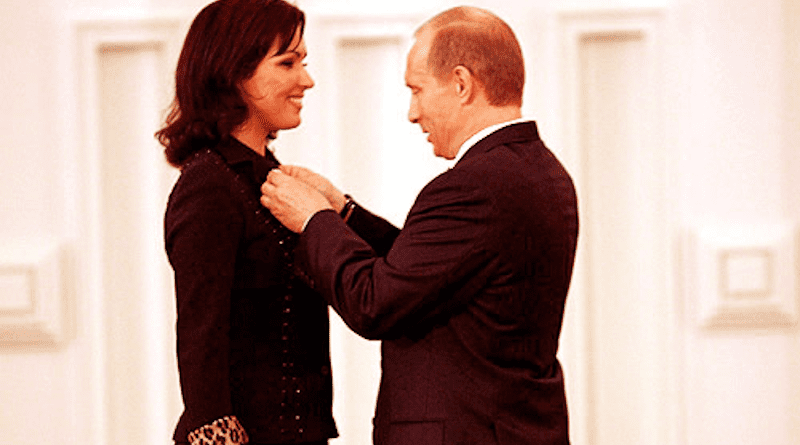Role Of Soft Power In Ukraine Conflict – OpEd
By Arab News
By Dr. Diana Galeeva *
Russian soprano Anna Netrebko was last week reportedly replaced in “Turandot” at New York’s Metropolitan Opera by the Ukrainian Liudmyla Monastyrska. Earlier last month, social media stories were circulating of Russian influencers cutting up their Chanel handbags in angry protest at the brand’s perceived “Russophobia.” These examples illustrate the deployment of “soft” sanctions, along with the more explicit political and economic restrictions.
In other words, the conflict in Ukraine also draws on cultural tools, including fashion, music and art.
The problem with soft power is always in how it is measured, both in general and in specific cases. One may ask to what extent the soft power sanctions might be effective in reaching political goals in the context of the Ukraine crisis.
And how does the current usage of them reflect theories about soft power?
The concept of soft power was introduced by American theorist Joseph Nye while analyzing America’s attempts at “attraction, rather than coercion.” He offered examples of soft power that were instrumental in the collapse of the Soviet Union and the subsequent establishment of the US as the world’s sole superpower.
While some parallels can be drawn between the 1990s and the current confrontation, there are some important differences, not least the distinction between positive self-promotion and soft sanctions that seek to damage the other side. There are question marks over how best to theorize the concept of soft power and if it is allowed to become broad enough to encompass all our examples so far.
The key idea behind soft power is winning the hearts and minds of others. Soft power consists of three resources: Political values, culture and foreign policies. The “American dream” of Harvard, McDonald’s and Apple won over the world with ideas, modernity, excellence and uniqueness, making people want to follow these tendencies.
Explaining how soft power operates, Nye argued that “co-optive power — the ability to shape what others want — can rest on the attractiveness of one’s culture and values,” meaning that a state should attract others with its products of culture or value. When McDonald’s opened its first Russian branch in Moscow in 1990, hundreds of people lined up to get their first Big Mac.
Such imagery, while appearing to be offering something desirable, also serves the purposes of destruction and coercion, which are normally associated with hard power. There is a tension here in which hard power — including economic sanctions — diminishes well-established soft power; it damages persuasion. Such policies contribute to the further growth of a multipolar vision of the world (in this case serving the main objectives of Russia’s actions) and create divisions, encouraging the target country to make use of what is either produced at home or to welcome the values (or brands) of “friendly states.” In other words, soft sanctions do not work as a form of co-optive power and the idea and principle of winning hearts and minds is automatically diminished.
Similarly, this crisis has contributed to the argument that soft power, in the form of Western liberal values, has been diminished toward another region — the Middle East. The welcome extended to Ukrainian refugees in Europe contrasts sharply with the earlier treatment of asylum seekers from Syria and other parts of the Middle East. Since the 2015 refugee crisis, more than 1 million asylum seekers have attempted to enter EU territory via the Belarusian borders with Poland and Hungary. In response, the Polish and Hungarian governments put up fences and refused to take in their share. As a result, many asylum seekers (mostly from the Middle East) became stuck in the forest near the border in sub-zero temperatures and without adequate medical assistance.
Should soft power — high and popular culture, including the arts, music, education, fashion, films, museums and values — have a role in this conflict? Perhaps, though not in the form we have largely witnessed so far. Culture helps artists and musicians express their views, but its role is usually in uniting people and bringing them together, along with sharing an untouched beauty that should bring messages of hope and peace.
As the concept of soft power is linked to attractiveness rather than division, it seems policies should be applied differently to achieve the aims of soft power. At a stage when the world is shifting toward more and fiercer confrontations, including the possible use of nuclear weapons, soft power’s effectiveness lies not in division, but rather as a solution. This is the only way forward in this conflict.
One crucial element of foreign policy, and diplomacy in particular, is to find routes to overcoming a crisis through softer approaches. Even when it seems to be too late to expect to find common ground and diplomatic solutions for all the parties involved, it seems the rest of the world could take a more active stance toward the soft power of diplomacy, aiming to find an acceptable end to this confrontation. This need not be seen as naively altruistic, since any country that succeeds in bridging these gaps will have opportunities to extend its own soft power along new pathways.
Soft sanctions may have a powerful effect on a domestic market, aligning a country’s people against the political enemy, but this is very different to producing cooperation and dialogue; no amount of canceled performances or destroyed handbags can achieve that.
- Dr. Diana Galeeva is an academic visitor to St. Antony’s College, Oxford University. Dr. Galeeva is the author of two books: “Qatar: The Practice of Rented Power” (Routledge, 2022) and “Russia and the GCC: The Case of Tatarstan’s Paradiplomacy” (I.B. Tauris/Bloomsbury, 2022). She is also a co-editor of the collection “Post-Brexit Europe and UK: Policy Challenges Towards Iran and the GCC States” (Palgrave Macmillan, 2021). Twitter: @diana_galeeva

